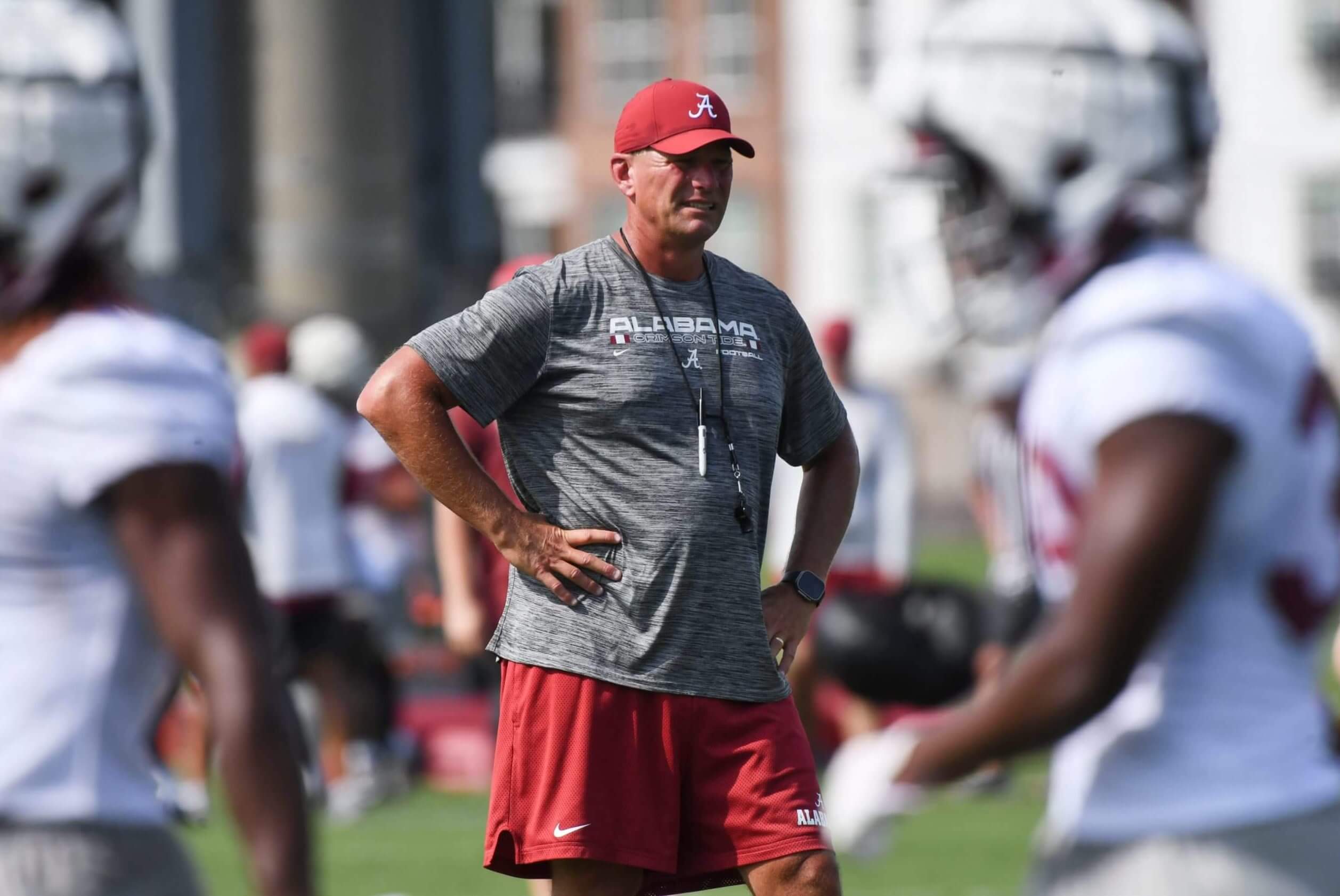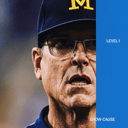In doing the research for my SEC predicted standings, I was struck by just how ridiculous some of the teams’ schedules are in this new format. I don’t know that they’re harder top to bottom (it’s still just eight league games), but the top half or so of Georgia and Alabama’s schedules are all bangers.
It’s going to be awesome for fans. Not so much the coaches.
Note: Submitted questions have been lightly edited for length and clarity.
Trying to project Alabama’s season, it has four important true road games against teams in venues where Alabama lost each game the last time it played there. How do you think they will do in these four games? — David T., Hoover, Ala.
The Pulse Newsletter
Free, daily sports updates direct to your inbox.
Free, daily sports updates direct to your inbox.
Sign Up
First off, I am very high on Alabama. The closer the season gets, the more I think Jalen Milroe is going to shred people in Kalen DeBoer’s offense. The receivers might not be 2023 Washington’s, but they’re pretty darn good, with five-star freshman Ryan Williams emerging as a likely starter alongside Kendrick Law and DeBoer’s former Huskies weapon Germie Bernard. Also: The Tide have really good leaders in Milroe, offensive lineman Tyler Booker, linebacker Deonte Lawson and safety Malachi Moore.
But as I said in my SEC predictions column, Bama may be a better team this season than in 2023, yet finish with a worse record because of exactly what David said. I don’t recall a Nick Saban team playing such a daunting road schedule (at least on paper) as this one, in part because the Tide avoided road nonconference games entirely from 2012 to 2021. And that’s on top of facing Georgia at home.
That said, Bama should still be favored in all four road contests. Week 3 at Wisconsin may be tricky just because it’s DeBoer’s first road game, and Camp Randall is a great environment. But the Tide are considerably more talented than the Badgers. And I’m not particularly high on Oklahoma, especially when the game is not until Nov. 23, by which point Bama will be fully formed.
The middle two — Tennessee on Oct. 19 and LSU on Nov. 9 — present the most danger. The Tide fell in Knoxville two years ago even with Bryce Young and Will Anderson. We don’t know yet if Nico Iamaleava can get the Vols’ offense back to Hendon Hooker-level scary, but the defense could be much better than it was then. And even though I’m skeptical LSU will be a top-10 team without Jayden Daniels, that game has gone down to the wire far more often than not in Baton Rouge.
It will be interesting to see how Alabama is perceived if it does drop more than one regular-season game. A year ago, that would have been “sky is falling” territory. But with a new coach, SEC expansion and the 12-team College Football Playoff, I would view 10-2 as a success for the Tide.

Kalen DeBoer’s first season as Alabama’s coach opens on Aug. 31 against Western Kentucky. (Gary Cosby Jr. / USA Today)
After the 2020 season, Jim Harbaugh had coached 10 seasons (six at Michigan) with roughly a 67 percent winning rate, zero conference titles and two postseason wins. He made the comments that the Wolverines were going to beat Ohio State “or die trying.” His teams then went 40-3 with three conference titles and a national title. Do you believe it is a coincidence that his tenure turned around when it did, or was it his willingness to do whatever it took to win? — Tim S.
I get the question, but it’s misleading to fold his first three years at Stanford into his overall resume and then ding him for it. He took over a 1-11 program and got it to 12-1 by his fourth season. It remains one of the great modern turnaround jobs.
Then, I would divide his Michigan tenure into three distinct eras:
2015-18: Harbaugh immediately began looking for any possible edge (remember the great satellite camp soap opera?). And the Wolverines were pretty darn good. They finished in the top 15 in three of the four years. The 2016 Orange Bowl team put 11 players in the draft the next spring. But going 0-4 against Ohio State, including a 62-39 meltdown in 2018, started to overshadow everything else and caused pressure to make changes.
2019-20: Harbaugh got away from what he knows. He hired a spread/RPO coach, Josh Gattis, to run his offense, and it mostly failed to click. He was noticeably more humble/guarded with the media. By then, he had proven to be a good but not great recruiter, which eventually reared its head. Michigan got drilled by the Buckeyes and Alabama to end the 2019 season, then never showed up in the shortened 2020 campaign, putting him on the hot seat.
2021-23: Harbaugh rebooted his whole program, bringing in a bunch of young assistants, most notably defensive coordinator Mike Macdonald, who worked for Harbaugh’s brother with the Ravens. Gattis stayed one more season, but Michigan went back to its smashmouth roots. And while the recruiting rankings don’t change, Michigan hit on a lot more than it missed, building a core that stayed together for three seasons. Everything clicked.
As for the other stuff, Austin Meek’s excellent story last week going inside the NCAA’s recruiting investigation included this telling paragraph:
A former recruiting director who spoke to the NCAA said Harbaugh urged him to “get guys to campus” and stated that Michigan had no protocols in place to avoid in-person contact during the dead period. According to the ruling, the former recruiting director told the NCAA, “The culture (in the football program) wasn’t to be safe, the culture was to go to the line and cross it if you had to.”

GO DEEPER
Did Jim Harbaugh vs. the NCAA really start with a burger? Our quest for answers at Michigan
It would be naive to think that mindset only took hold in 2021 and only applied to recruiting visits. It’s who Harbaugh is. “Die trying.” And so, like with all things Harbaugh/Michigan, some (including all in Ohio) will say those misdeeds invalidate the whole run, some (mostly in Michigan) will say it’s a complete nothingburger, and the truth is somewhere in between.
On the podcast, you mentioned how it was unprecedented Washington will be starting the season unranked despite appearing in the most recent national championship game. Let’s pretend Washington got lucky on a few more big plays and squeaked out a win vs. Michigan. Even if their roster was identical as it is now, would the voters leave the defending champ unranked going into the season? — Dylan P., Portland, Ore.
Good question. Probably not, although I don’t know what the voters would be using to justify that ranking besides inertia.
The closest analogy I can think of to Washington this season is Auburn in 2011, post-Cam Newton. Those defending national champion Tigers, who returned just seven starters, started the following season ranked 23rd, and even that proved generous. The Tigers went 4-4 in the SEC and 8-5 overall in what would prove to be Gene Chizik’s second-to-last season with the Tigers.
That Auburn team featured a bunch of salty veterans compared with this Washington team, which returns just two starters, both on defense. Plus, it has an entirely new coaching staff. Other than wearing the same uniforms as last season, the Huskies will bear almost no resemblance to last year’s 14-1 team. That makes it difficult to justify ranking them.
But there’s an important distinction between 2011 Auburn and 2024 Washington. The former did not have the transfer portal at its disposal. The replacements for those 15 departed starters had to come almost entirely from within, which all but assured they would be either younger players or career backups.
New Washington coach Jedd Fisch is in a much different boat. For one thing, he is replacing Michael Penix Jr. with a four-year SEC starter, Will Rogers from Mississippi State. New running back Jonah Coleman averaged 6.8 yards per carry for Arizona last season. New receiver Jeremiah Hunter gained 2,084 yards in three seasons at Cal. New defensive tackle Sebastian Valdez and safety Cameron Broussard were FCS all-conference standouts.
So perhaps Washington could wind up making the pollsters look dumb. But it would be one heck of a coaching job by Fisch to mold all the new people in that building into a Top-25 team in the span of eight months.
I see lots of fans and/or media refer to certain fans as “die-hard.” What defines this level of fan for college teams? — Jordan H., Lincoln, Neb.
I believe this falls in the category of “I know it when I see it.” But at the bare minimum, I would say the criteria include:
Someone who wears at least one piece of school clothing roughly 150 days per year.
Someone who watches every game or if there’s an unavoidable conflict, goes to great lengths to not find out the score until they can.
Someone who reads The Athletic every day.
What do you think the explanation is for the soft-middle and bottom of the Big Ten (pre-2024 expansion)? Michigan, Ohio State and to some extent, Penn State have been in the top five or 10 consistently after COVID-19, but there’s a huge cliff after that. These schools are cashing in big time, shouldn’t that money translate to the field? — Andrew F.
All the TV money in the world is not going to turn Purdue or Indiana into a recruiting juggernaut.
For as long as there have been recruiting rankings, those three were the only Big Ten programs to regularly crack the various services’ top-25 classes, much less the top five or 10, while half of the SEC lands in the top 15 and two-thirds in the top 25. That disparity was not as stark, say, 40-50 years ago, but as the population has continued to shift from the Rust Belt states to the South, so, too, has football talent.
Ohio State, Michigan and, to some extent, Penn State, have been able to overcome that by recruiting nationally. Most of the others can’t bring in droves of four-star prospects from Florida or Texas, while Michigan State (when it was rolling under Mark Dantonio), Wisconsin, Iowa, etc., have followed more of a regional model with an emphasis on development. That is great for winning eight to 10 games every year and reaching Citrus and ReliaQuest bowls but not national championship contenders.
Interestingly, the recent Big Ten expansion, which was driven entirely by TV sets, has an opportunity to greatly shift the perception of the program, as Oregon, USC and, to a lesser extent, Washington, have a higher recruiting ceiling than 11 of the 14 existing schools. And the timing could not be more important, as the conferences will be evaluated almost entirely on CFP performance.
Had the Big Ten stood pat, the notion of a “Power 2” might have quickly crumbled. The SEC’s 14 would greatly outperform the Big Ten’s 14 over time. We know this because it’s exactly what happened in the four-team era. SEC teams won six national titles to the Big Ten’s two. The SEC went 16-6, the Big Ten 5-7.
If you include each league’s new schools, the SEC’s record moves to 16-11 (Oklahoma and Texas were a combined 0-5), the Big Ten’s goes up slightly to 7-10 (Washington and Oregon were a combined 2-3). That’s still quite the gap, but among the Ducks, Huskies and USC, there’s no reason at least one can’t get a team in most years, and if so, possibly win a couple of games.
Which team is your pick to have the biggest gain in wins from last year to this year? — Reggie C., San Diego
It likely will be a Group of 5 team that nobody could have seen coming, a la UNLV (from 5-7 to 9-5) and Texas State (from 4-8 to 8-5) last season, but let’s try to guess anyway.
An obvious one is Sam Houston. The Bearkats had a rough first season in FBS, going 3-9, but K.C. Keeler was a national championship FCS coach. They won’t be down for long. Sam Houston had no offense whatsoever during the first half of the season but got notably better as the Bearkats won three of their last four. The defense was strong enough to hold BYU to 14 points, Air Force to 13 and Fiesta-bound Liberty to 21. It would not surprise me if Keeler’s team goes from three wins to eight or nine.
Colorado State was 5-7 last season but took Colorado to overtime, knocked off eventual Mountain West champ Boise State and came within a last-second field goal at UNLV. Quarterback Brayden Fowler-Nicolosi was impressive as a true freshman (he supposedly turned down a $600,000 NIL offer elsewhere) and the program gets back All-MWC receiver Tory Horton. The Rams could contend for a conference championship.
Finally, why not Washington State? Jake Dickert’s program underachieved in going 5-7 last season but will be playing a considerably easier schedule than it did in the Pac-12, with eight games against FCS or Group of 5 opponents. And while losing quarterback Cam Ward hurts, the Cougars did not suffer the same degree of attrition as Oregon State. It has an experienced offensive line. On schedule alone, Wazzu should win at least eight games.
Do you see a team getting into the Playoff without a “big win?” Say Tennessee loses to Alabama and Georgia convincingly but runs the table the rest of the way, beating an Oklahoma that gets roughed up by its brutal schedule and has five losses and NC State, which turns out to be a letdown. — Graham, Atlanta
Sure, because that happened even when it was four teams. Alabama in 2017 was 11-1 and did not reach the SEC championship game, and the highest-ranked teams it had beaten were No. 17 LSU and No. 23 Mississippi State. Ohio State in 2022, also 11-1, had wins over No. 11 Penn State and No. 21 Notre Dame. But they were both seen as preferable to a two-loss team.
The goal posts move in a 12-team CFP, but unless the committee completely changes its approach, nearly any 10-2 Big Ten or SEC team is going to get in ahead of someone else’s 9-3 team. The only two-loss teams from those conferences that would not have made the cut during the past 10 seasons were Northwestern in 2015 and Alabama in 2019. The Wildcats likely got dinged because their two losses were 38-0 at Michigan and 40-10 to Iowa. The Tide finished a spot below 9-3 Auburn, which they had lost to a week earlier.
TBD on a two-loss ACC or Big 12 team. I’m as curious as the next person to see how the committee weighs a two-loss team from a weaker conference vs. a three-loss team from the Big Ten or SEC.
I would brace yourself now for the likelihood that those last few “bubble teams” every year will not have great resumes. Last season, the final at-large berth would have come down to a 10-2 Ole Miss team with one good win (9-3 LSU) and a 52-17 loss at Georgia or a 10-2 Oklahoma team with one huge win (12-1 Texas) but only three total against foes that finished above .500.
I’m sure some of the more dour folks in our comments section will have a field day with this answer.
If you could pick which first-round matchups you want to see happen this year, purely for narrative or entertainment value, which would you pick? Brian Kelly and LSU in South Bend? Lane Kiffin vs. USC? — Andrew R.
Kelly returning to Notre Dame would be epic. So would Lincoln Riley taking USC to Oklahoma. It would be fun if we got some realignment-disrupted rivalries temporarily restored, like if the Sooners drew Oklahoma State, Texas visited Texas Tech or Missouri faced Kansas. (Can we move that one to Kansas City?)
But mostly, I just want to see great games between programs that don’t often see each other at one or the other’s home stadium. Say, Alabama at Oregon. Or Ohio State at LSU. Or USC at Clemson. Or Florida State at Michigan. That’s what this 12-team thing should be all about.
Just think, on Dec. 21 last year, the only college football game was a 45-0 USF rout of Syracuse in the Boca Raton Bowl. A year later, that same date could theoretically be a tripleheader like Oregon at Ole Miss, Miami at Utah and Penn State at Texas.
Take that, dour commenters.
College football is ridiculous, unfair and hypocritical. My team will never win the national championship and is usually eliminated from contention in the first month. So why am I so excited every time the season starts, and why do I watch it so religiously every Saturday? — Melissa B.
Because there is truly nothing like the 14 straight hours of pure, unadulterated chaos on a college football Saturday.
Have at it, commenters.
(Top photo of Jalen Milroe: Sean M. Haffey / Getty Images)
Source link : http://www.bing.com/news/apiclick.aspx?ref=FexRss&aid=&tid=66bc7a879a81488ebb68b4494c8e408c&url=https%3A%2F%2Fwww.nytimes.com%2Fathletic%2F5699725%2F2024%2F08%2F14%2Falabama-football-jim-harbaugh-michigan-football%2F&c=9986702461384093107&mkt=en-us
Author :
Publish date : 2024-08-13 22:00:00
Copyright for syndicated content belongs to the linked Source.






